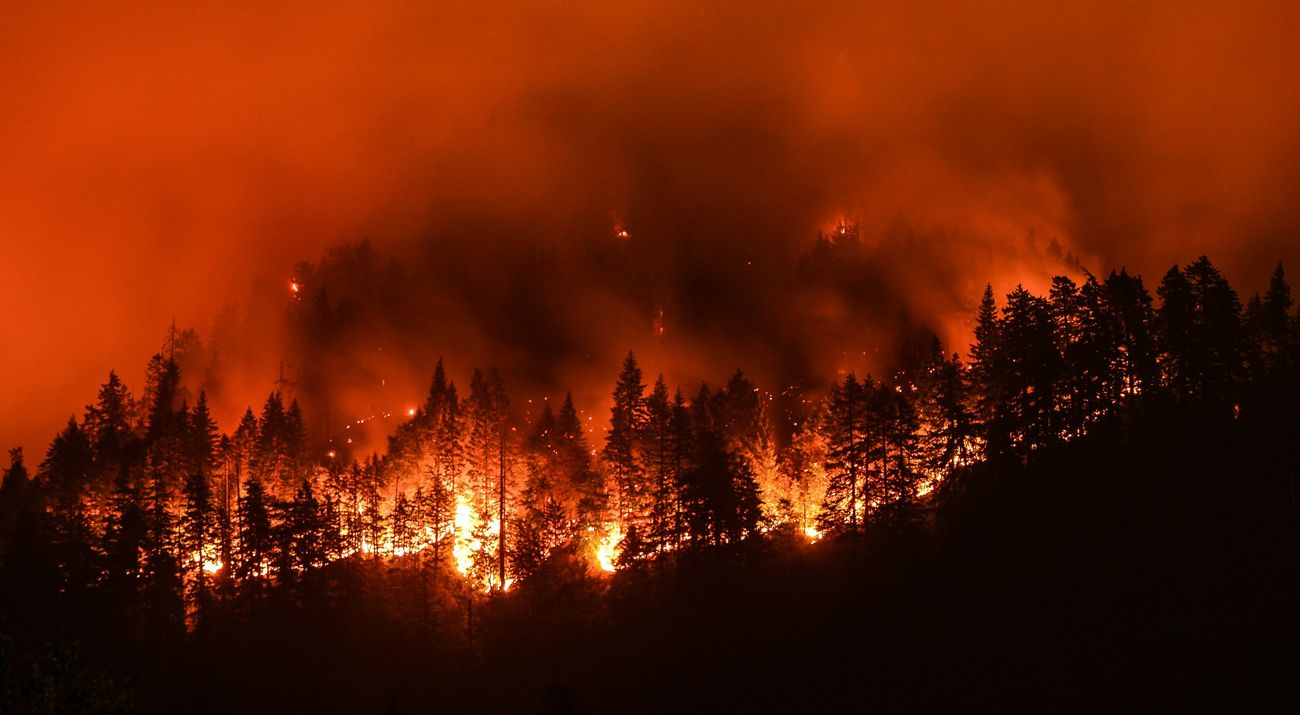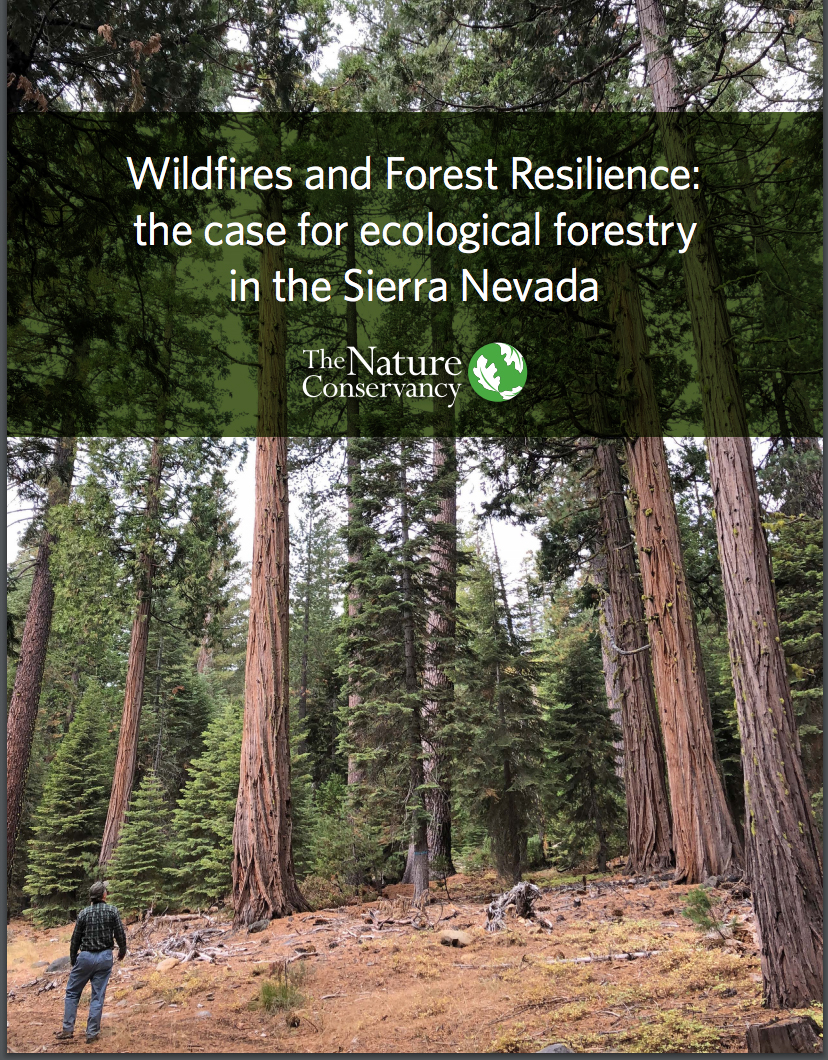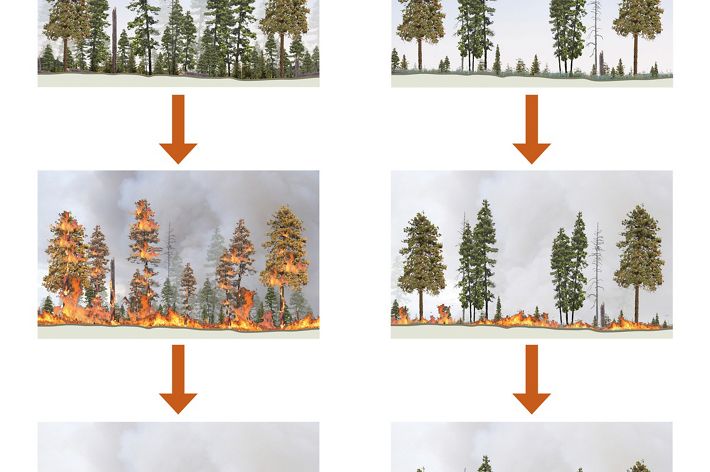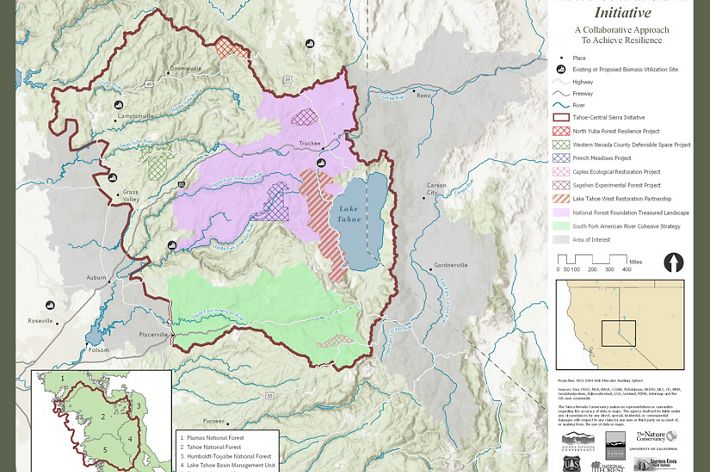Let’s Fight Fire with Fire
There is a future where fire restores our forests instead of destroying them.
A devastating trend
Catastrophic wildfires in California continue to set new records for the “largest,” “most damaging,” “worst air quality” and sadly, “deadliest” we’ve ever seen.
The Problem | Megafires
It took 100 years to destroy the health of Sierra forests, but with the right resources, we can restore our forests in mere decades.
Thanks to Smokey Bear, a century of fire exclusion and the forced removal of Indigenous forest stewards, California’s Sierra forests are dangerously overgrown. Now, trees are packed together at up to five times their natural density, and fires that should regenerate our forests explode into infernos that destroy them. These forests help provide 60% of our state’s developed water supply, and losing them would leave millions of people without clean drinking water.
TNC has a plan to reverse this terrible trend: Ecological Forest Restoration.
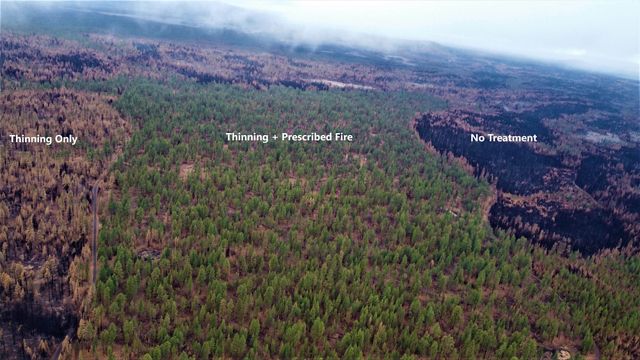
Sierra forests evolved with frequent fire, which removed brush and helped space out trees. In the right amount, fire recycles critical nutrients in forest soil and stimulates new growth. Ecological Forest Restoration is a proven technique to prepare forests to withstand extreme fire by removing brush and small and unhealthy trees, and then conducting controlled burns.
Indigenous Peoples understand the importance of frequent, controlled fire. For millennia, they have tended the forests of the West with cultural burning practices. It’s time to follow Indigenous leadership and re-establish these practices across California.
The Science Behind Forest Restoration
Our paper, Wildfires and Forest Resilience: the case for ecological forestry in the Sierra Nevada, cites over 130 scientific studies to make the case for ecological forestry as the best solution to combat megafires in California’s fire-adapted conifer forests. Our major findings are:
Ecological Forest Restoration (ecological thinning combined with controlled burns) can significantly reduce the risk of megafires in fire-adapted conifer forests. Additionally, this practice helps combat the effects of drought and climate change, with significant benefits for air quality, water quality, carbon storage and wildlife habitat.
Now it’s time to apply these practices on a landscape scale. TNC’s French Meadows project is an example of what a large-scale restoration looks like.
Download
Got questions? We’ve got answers!
-
No. Industrial style logging techniques like clear cutting remove every tree in a given area, but Ecological Forest Restoration is designed to remove only the smaller trees that have grown in the absence of frequent fire while protecting older, more established trees. The process begins with “ecological thinning,” the strategic removal of smaller or unhealthy trees that can bring fire up into the forest canopy where it can more easily spread to healthy trees and become a severe fire. This process is designed to remove overgrown plants and trees that act as fire fuels and protect a forest’s larger, healthier and more fire-resilient trees.
FIRE FACT: Ecological Forest Restoration improves the way the forest functions. The trees that are removed during Ecological Forest Restoration are selected based on extensive science and field observation, with the goal of making sure that the surrounding trees can survive a severe fire. Thinning reduces competition for limited soil moisture which increases tree growth and strengthens its defense system to insect outbreak and drought.
-
No. Smokey Bear told us that it was our job to prevent forest fires, and while preventing unwanted fires is a good idea, eliminating the role of fire in many forests is not. Historically, the forced removal of Indigenous Peoples and cultural burning, livestock grazing, industrial logging of fire resistant trees and finally a policy of fire suppression, left our forests unhealthy and overgrown.
FIRE FACT: Western dry forests evolved WITH frequent fire (see map). Low-severity fire is critical to sustaining forest health in dry, lower elevation forests and can help fire workers better reduce the risk of severe fires. Indigenous Peoples tended Western forests using intentional fires and lived productively with fires caused by lightning strikes and other natural phenomena for millennia. Now, it’s time to elevate the value of these practices and expand the safe use of fire by Indigenous and non-Indigenous practitioners.
-
Controlled burns rarely get out of control. In 2022, the U.S. Forest Service reported 99.84% of prescribed fires go as planned. Burns are staged by trained fire professionals who ensure that the timing, weather conditions and moisture levels are right to keep fire from spreading beyond designated boundaries. Practitioners use best practices and extensive planning to prevent accidents, but recent changes in climate and weather require re-examination of how to apply this tool.
FIRE FACT: Controlled Burns help reduce the impacts of extreme wildfires.. Forests that have been treated with thinning and prescribed fire have healthier spacing and less fuel, making wildfires less severe and destructive.
-
Controlled burns are managed by trained, experienced fire practitioners who evaluate all the necessary factors—weather, moisture levels, humidity, wind and more—to ensure conditions are exactly right for a safe and controlled burn. Because the timing is carefully planned, there is greater opportunity to control where smoke goes and to work with local communities to minimize disruption.
FIRE FACT: Wildfires, on the other hand, can burn unpredictably for weeks or months on end, threatening homes and infrastructures and blanketing entire regions with smoke. Smoke from wildfires can be particularly toxic because it contains particles from buildings and cars.
-
No. Wildlife need a home and if a megafire destroys the forest, and with it, habitat for many species, there is nowhere for species to live. Restoration also opens forests to the light and moisture, allowing trees and plants to grow and provide food for wildlife.
-
When we use these restoration tools effectively, our forests and the communities around them are less likely to experience megafires. With proactive treatment, communities are better protected from severe wildfires. At the same time, forests become more resilient—able to withstand climate change.
FIRE FACT: Fire Adapted Communities offer community-based leaders, resources, tools and connections to reduce their wildfire risk and increase community preparedness. Fire Adapted Communities Learning Network focuses on relationships each community has with the landscape around it. Fire Adapted Communities is a catalyst for spreading fire adaptation practices and innovations nationwide.
Ecological Forest Restoration protects more than just trees. 60% of California’s clean water supply comes from Sierra Nevada forests. Forests clean our air, store carbon and provide habitat for wildlife. But megafires threaten everything forests do for people and nature. In California, by protecting our forests, we are protecting amazing species like brown bear, mountain lion and the iconic California spotted owl.
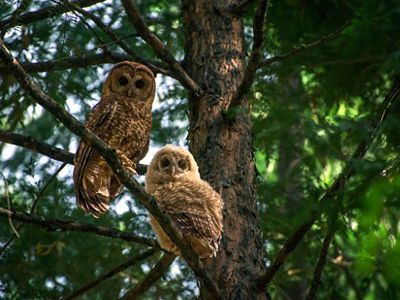
Quote: David Edelson
It creates a vicious cycle: When forest restoration is put on hold, the risk of megafires increases. When megafires happen, it reduces the funds available to better manage our forests.
Investing in Resilient Communities
In the face of megafires, we have a responsibility to invest in and create fire resilient communities. To do this, we must thoughtfully consider where we build new homes for California’s ever-growing population, as well as how we adapt our existing communities to deal with the escalating threat of fires.
This is particularly true in the coastal and foothill regions of central and southern California, where many people live within and next to highly flammable shrublands. In these areas, vegetation management and controlled burns may make matters worse. Our best defense in these areas is a robust investment in community protection measures focused on preventing human-caused ignitions and creating fire resilient communities.
For communities that have already been established in high-risk fire areas, we must make those homes and communities more resilient to fire through fire-safe building retrofit incentives, science-based defensible space programs, evacuation planning and prevention of human-caused ignitions. Developing updated Disaster Preparedness Plans and investing in early detection and fire suppression systems in the most dangerous weather conditions can also further protect communities.
We also need to rethink the land-use policies that put people in harm’s way. We need new policies that provide incentives to build in safe and sustainable locations. We also must ask hard questions in the face of these fires—such as how do we respond to increasing risks from climate change factors including fire, floods and rising sea levels? We need new solutions to incentivize building in locations that enhance public safety and make our communities more resilient.
In places like the Sierra Nevada, resilient communities require smart development planning AND healthy forest management. In more shrub-dominated landscapes, smart decisions about where and how we build our communities and identifying measures to reduce ignitions can greatly reduce risk to people, making their homes more secure.
What We’re Doing and How You Can Help
TNC is working hard to break the cycle of disastrous megafires in the Sierra Nevada. We us on-the-ground science, education and advocacy to conduct and promote techniques that work and to advocate for state policies that:
- Promote Ecological Forest Restoration and fuels reduction in fire-adapted forests like the Sierra Nevada;
- Take a landscape scale approach to forest restoration across multiple watersheds and prioritizing high impact and large-scale projects;
- Invest in policies and programs that promote fire resilient communities by directing growth away from high fire risk zones and creating options for communities already in harm’s way.
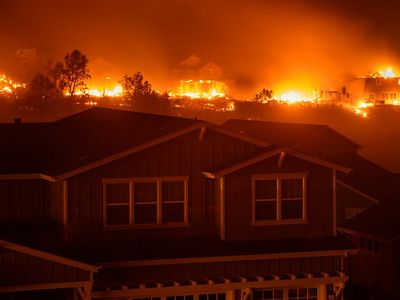
Wildfire Resilience Insurance
We know that ecological forest restoration practices make fire-adapted forests healthier and reduce the risk of severe wildfire. But should insurance losses and pricing be lower where ecological forest practices have taken place?
The answer is yes. Working with our global insurance partner Willis Towers Watson, TNC used our French Meadows Restoration Project in the Sierra Nevada (See Case Study #2 below) as a test case to determine whether the risk reduction benefits of ecological forestry could be incorporated into insurance modeling, structuring and pricing.
The results were exciting. For the first time, we incorporated ecological forestry into insurance modeling and pricing. Our study quantifies the insurance benefits of ecological forest restoration including insurance premium savings for communities and businesses in or near forests.
The insurance savings from ecological forestry can be captured and used to fund or finance forest restoration. The results also encourage increased investment in ecological forestry practices from both the public and private sector.
Read our full report and summary here.
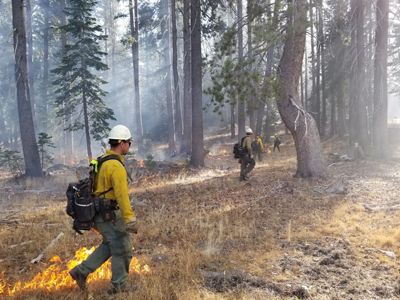
More Science and Case Studies
In the Sierra Nevada, TNC’s science is leading the way in better defining the problems facing our forests and solutions by:
Setting out a scientific case for ecological forestry as the linchpin strategy for reducing the risk of megafires in our forests
Prioritizing Sierra watersheds for restoration with respect to biodiversity value and risk to communities
Showing partners that investing in ecological forestry makes economic sense and also benefits people and nature
Here are three pilot projects underway in the Sierra Nevada that helped inform our forest restoration recommendations to curb the cycle of megafires.
Case Study #1: Independence Lake Preserve
TNC is using our 2,325 acre Independence Lake Preserve, located in the northern Sierra Nevada near Truckee, as a demonstration site for forest restoration. High-severity wildfire is a significant threat to the water supply, neighboring communities and wildlife that thrive here. Since 2010, TNC has used ecological thinning and controlled burning to reduce wildfire risk and promote healthier, more resilient forests at the preserve.

Case Study #2: French Meadows Forest Restoration Project
TNC is partnering with the U.S. Forest Service, Placer County Water Agency, Placer County, the Sierra Nevada Conservancy, American River Conservancy and the Sierra Nevada Research Institute at UC Merced to restore 28,000 acres of forest in the headwaters of the Middle Fork of the American River, just west of Lake Tahoe. We believe this partnership can serve as a model to increase the pace and scale of forest restoration on national forest lands throughout the Sierra. TNC just published a Lessons Learned Paper on behalf of the French Meadows partners summarizing the elements that were key determinants to the success of our partnership and making policy and practice recommendations for future partnerships.
Key elements of the project include:
- Collaborative management, allowing the project to advance quickly and efficiently
- Funding from a wide variety of federal, state, local and private sources
- Shared stewardship to accelerate on-the-ground restoration with TNC helping to direct use of prescribed fire
- Research on how forest restoration benefits water supply and forest health
- Innovative planning, including use of state-of-the-art fire behavior modeling

Case Study #3: Tahoe-Central Sierra Initiative
Independence Lake and French Meadows are part of the much larger Tahoe-Central Sierra Initiative (TCSI), covering approximately 2.4 million acres around Lake Tahoe and the central Sierra Nevada. TNC is part of a diverse coalition bringing together innovative approaches to increase the pace and scale of restoration work across this entire region. The TCSI initiative is improving the health and resiliency of forest ecosystems and communities by:
- Raising federal, state and private funding
- Using a rigorous planning and analytic process (co-led by TNC) to develop forest restoration approaches that can influence the entire landscape
- Analyzing the benefits to clean water, clean air, wildlife habitat and other values from implementing the forest restoration scenarios
Definitions
- MEGAFIRE: a fast-moving, high intensity forest fire that burns a large area, typically 100,000 acres or more
- FOREST RESTORATION/ECOLOGICAL FORESTRY: the use of forest thinning in combination with controlled burns, where it is safe and appropriate, to reduce high fuel loads that contribute to megafires
- FOREST THINNING: strategically removing smaller trees and brush from conifer forests that fuel megafires
- CONTROLLED BURN: an intentionally-ignited fire contained within a designated area. the goal is to remove highly-flammable undergrowth (and thus reduce the risk of megafire) while promoting healthier forest conditions
- MANAGED WILDFIRE: lightning-ignited fires that can be safely managed for the benefit of nature while reducing the risk of future megafires
Our work to curb the cycle of megafires is far from over. TNC is uniquely positioned to protect our fire-adapted forests and help communities prepare for climate-exacerbated natural disasters. Let’s stop making history and start fixing the problem.
